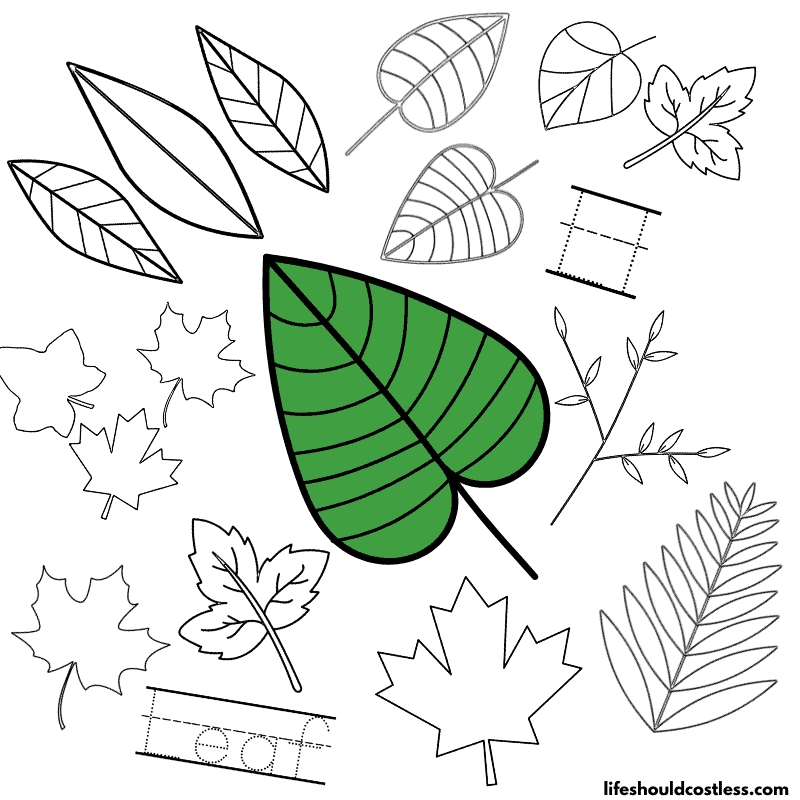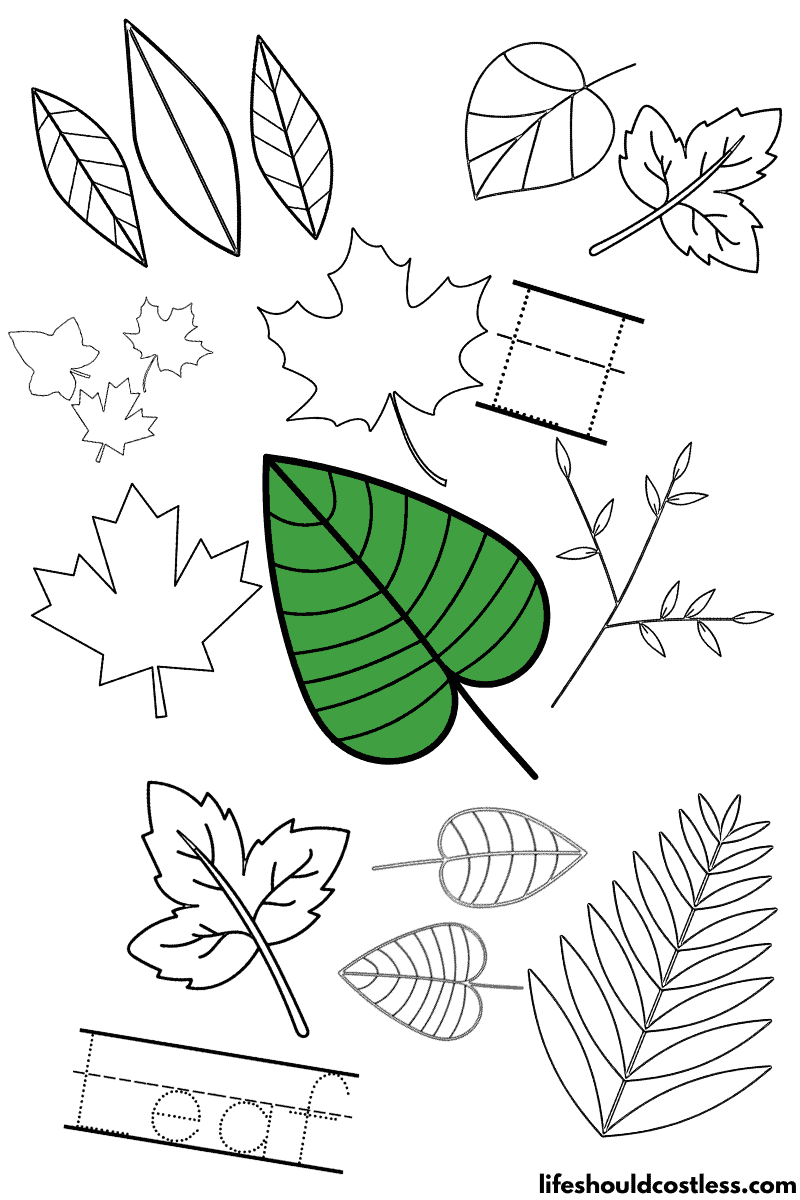These leaf coloring pages are a fun and educational way to teach children about the natural world while also encouraging creativity and artistic expression. With a wide variety of leaf designs available, children can explore the diversity of leaves and their shapes, sizes, and colors found in different types of trees and habitats. Whether used as a standalone activity, or incorporated into a larger lesson plan (with lots of fun and interesting facts included in this article), these pages provide a fun and engaging way for children to learn about nature and develop their artistic skills.
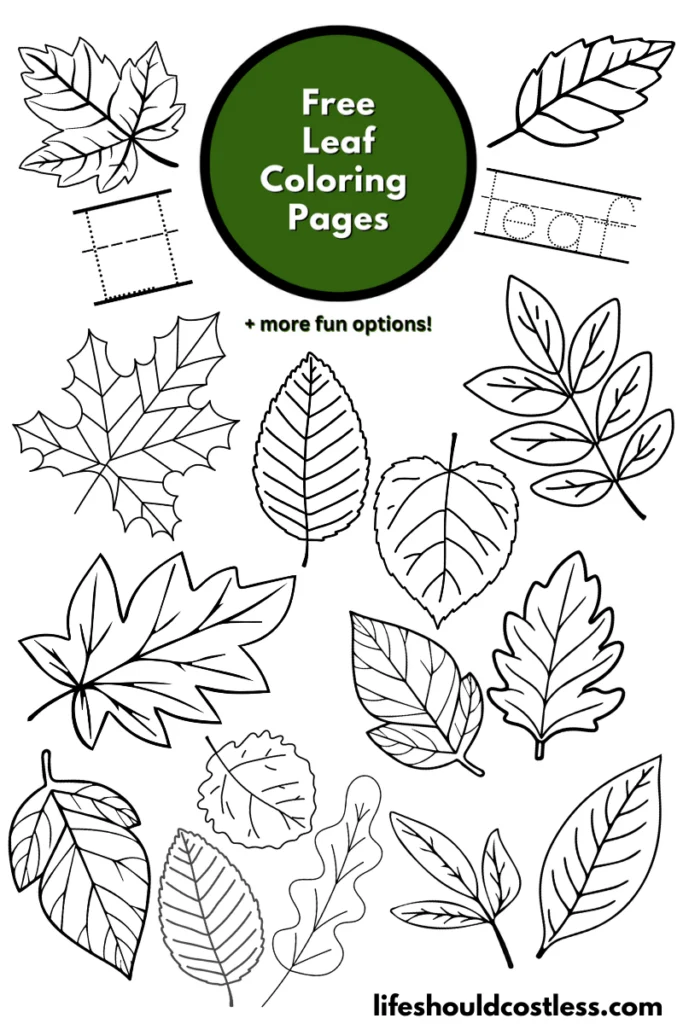
Feel free to select the design that appeals to you the most.
Then save the downloadable free PDF template, print it out, & get coloring to your little hearts content.
Or alternately, you could even use them as an embroidery pattern or inspiration for fine line tattoos.
Table of Contents, Skip Ahead To What You're Looking For
Leaf facts
For those who are new to my coloring pages, it’s worth noting that I enjoy providing the opportunity to delve into the subject matter, allowing you to seamlessly transform your coloring experience into an educational lesson.
So, let’s embark on this educational journey together!
Leaves are fascinating and diverse structures in the plant kingdom. Here are some fun and interesting facts about leaves:
- Photosynthesis Powerhouse: Leaves are the primary sites for photosynthesis, a vital process where plants convert sunlight, carbon dioxide, and water into glucose and oxygen. This process sustains life on Earth by providing oxygen and food.
- Leaf Shapes: Leaves come in a wide variety of shapes and sizes. They can be simple, like the oval leaves of an oak tree, or complex, like the intricate patterns of a fern frond.
- Leaf Pigments: The green color of leaves comes from chlorophyll, the pigment responsible for capturing light energy. However, leaves can contain other pigments too, like carotenoids (orange and yellow) and anthocyanins (red and purple), which become more visible in the fall.
- Leaf Veins: Leaves have intricate vein systems that transport water, nutrients, and food throughout the plant. The main veins are called the midrib, while smaller veins form a network called the venation pattern.
- Adaptations: Leaves have various adaptations to suit different environments. For example, desert plants often have small, thick, or spiky leaves to reduce water loss, while aquatic plants have thin, flexible leaves to thrive in water.
- Leaf Lifespan: Leaves have different lifespans. Some are deciduous and fall off in the fall, while others are evergreen and last throughout the year. Deciduous trees shed their leaves to conserve water and energy during the winter months.
- Autumn Colors: In the fall, leaves change color due to the breakdown of chlorophyll and the presence of other pigments. This vibrant display of reds, oranges, yellows, and purples is a result of various factors, including temperature and light.
- Leaf Identification: Botanists use characteristics such as leaf shape, size, margin (edge), and venation to identify plant species. Leaf identification guides and apps are valuable tools for nature enthusiasts.
- Leaf Anatomy: Leaves have several layers, including the cuticle (outer protective layer), epidermis (skin-like layer), mesophyll (where photosynthesis occurs), and stomata (tiny openings for gas exchange).
- Record-Breaking Leaves: When it comes to extraordinary leaves, there are notable extremes. In the plant kingdom the Giant Amazon Water Lily (Victoria amazonica), which boasts leaves that can span an impressive 10 feet (approximately 3 meters) in diameter is absolutely huge. Conversely, the tiniest leaves are found on specific aquatic plants, measuring just a few millimeters in size.
- Medicinal Leaves: Many leaves have medicinal properties. For example, tea is made from the leaves of the Camellia sinensis plant, and the leaves of Aloe vera are used to treat skin conditions. Various herbs and spices, like basil and mint, are also prized for their flavorful leaves.
- Leaf-Folding Plants: Some plants have unique mechanisms involving leaves. The sensitive plant (Mimosa pudica) folds its leaves when touched, while the pitcher plant has specialized leaves that form a pitfall trap to capture insects.
- Leaf Structures: Different plants have evolved distinct leaf structures. For instance, the needles of coniferous trees help reduce water loss in cold climates, while the broad leaves of tropical rainforest plants maximize sunlight absorption.
- Leaf Fossils: Fossils of ancient leaves provide valuable insights into Earth’s history and climate. Paleobotanists study these fossils to learn about past ecosystems and environmental changes.
- Leaf Crafts: Leaves have been used in various cultural and artistic traditions. Pressed leaves are commonly used in crafting, and leaf motifs can be found in traditional textile patterns, pottery designs, and more.
Who knew that leaves could be such an interesting topic!?
We sure learned a lot about leaves, but there is definitely more to know about them.
If you would like to learn more about leaves, here are some reputable resources to use in your quest for knowledge:
- https://www.britannica.com/science/leaf-plant-anatomy
- https://www.thoughtco.com/plant-leaves-and-leaf-anatomy-373618
- https://en.wikipedia.org/wiki/Leaf
- https://www.youtube.com/watch?v=B2TYeQp0Bw0
- To see all of my free printables, go here.
- To see an alphabetized index of my coloring pages, go here.
- To see all of my botanicals coloring pages, go here.
- To see all of my floral coloring pages, go here.
- To see all of my holiday/seasonal coloring pages, go here.
- To see all of my fall/autumn coloring pages, go here.
Printing instructions
*Keep in mind that while these coloring sheets are free, they are for personal use only. Any additional use will need written permission, from me, obtained via email. Thanks.*

How to get best results with your leaf printable
These coloring leaf pages are a great way to teach children about nature while also promoting creativity and artistic expression.
Materials
- Black Ink/Toner
- Standard 8.5"x11" Printing Paper (or quality cardstock)
Tools
- Computer/ Phone/ Or Tablet To Download To
- Printer
- Pencil Sharpener
- Colored Pencils
- Eraser (optional)
Instructions
-
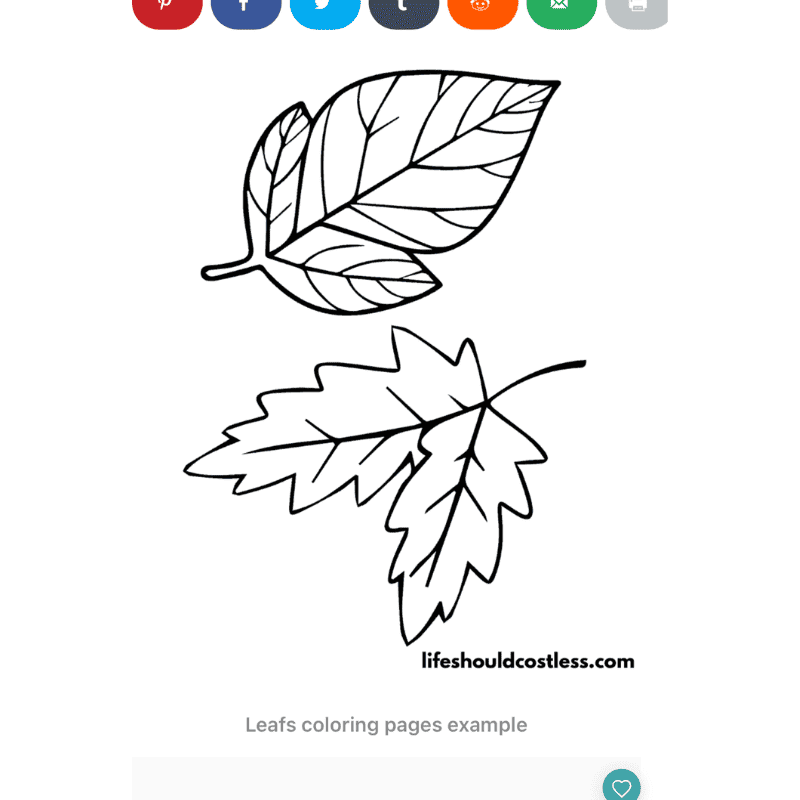 Feel free to browse through the selection of coloring pages options and select the image or images you wish to color. The sample image(s) provided, displaying the website's watermark at the bottom, give you a preview of the complete PDF image's appearance.
Feel free to browse through the selection of coloring pages options and select the image or images you wish to color. The sample image(s) provided, displaying the website's watermark at the bottom, give you a preview of the complete PDF image's appearance. -
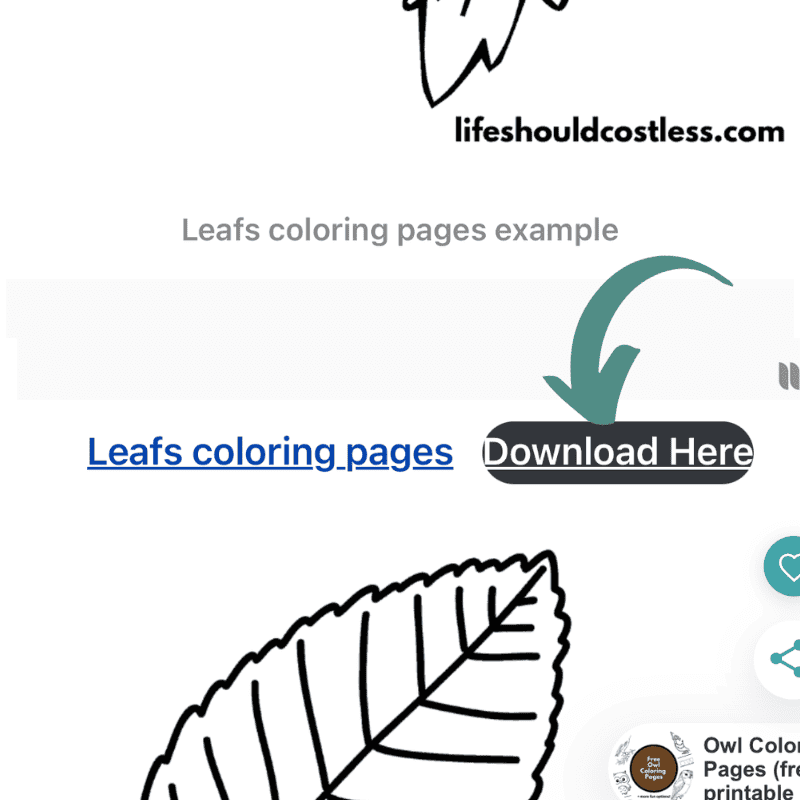 Direct your gaze slightly downward from the desired sample image to find the "download here" button for the attached PDF file.
Direct your gaze slightly downward from the desired sample image to find the "download here" button for the attached PDF file. -

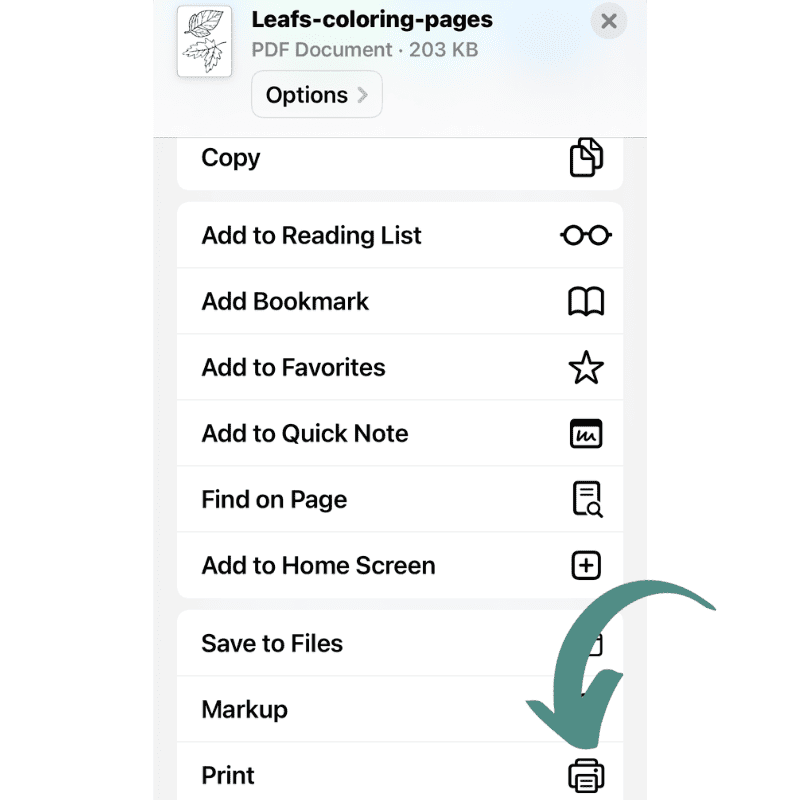 First select download, and then select the print option.
First select download, and then select the print option. -
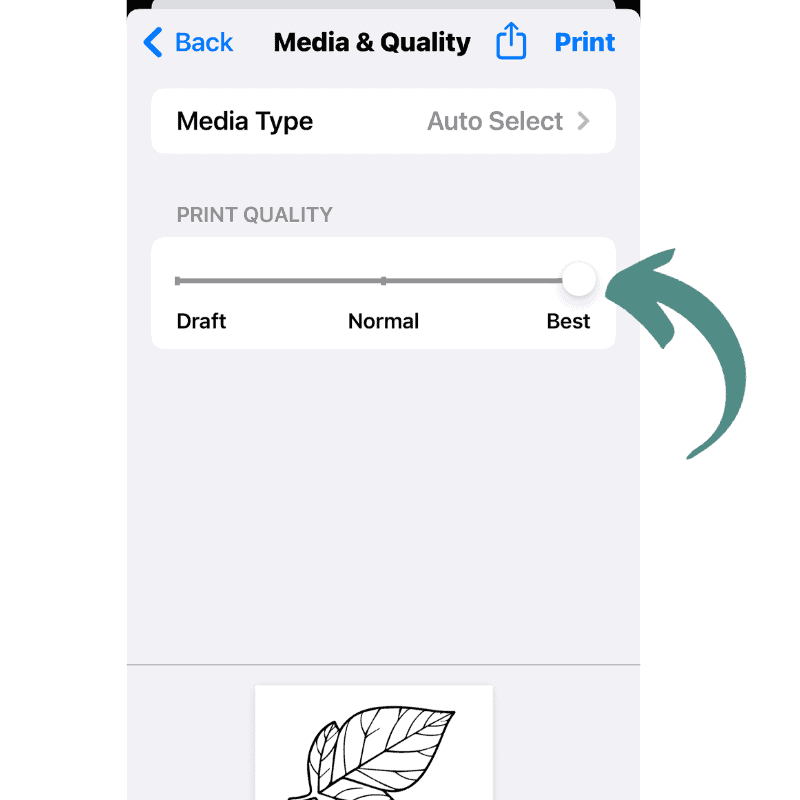 When you're prepared to print, please ensure that you select the highest-quality print setting available.
When you're prepared to print, please ensure that you select the highest-quality print setting available. -
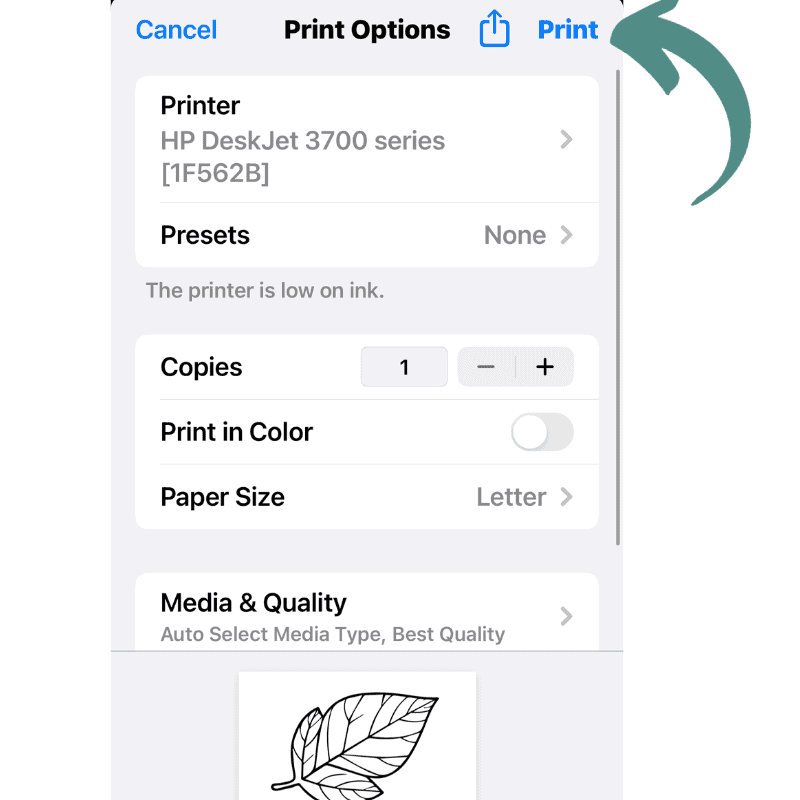 Go ahead and select "print". Then send it to your printer of choice.
Go ahead and select "print". Then send it to your printer of choice. -
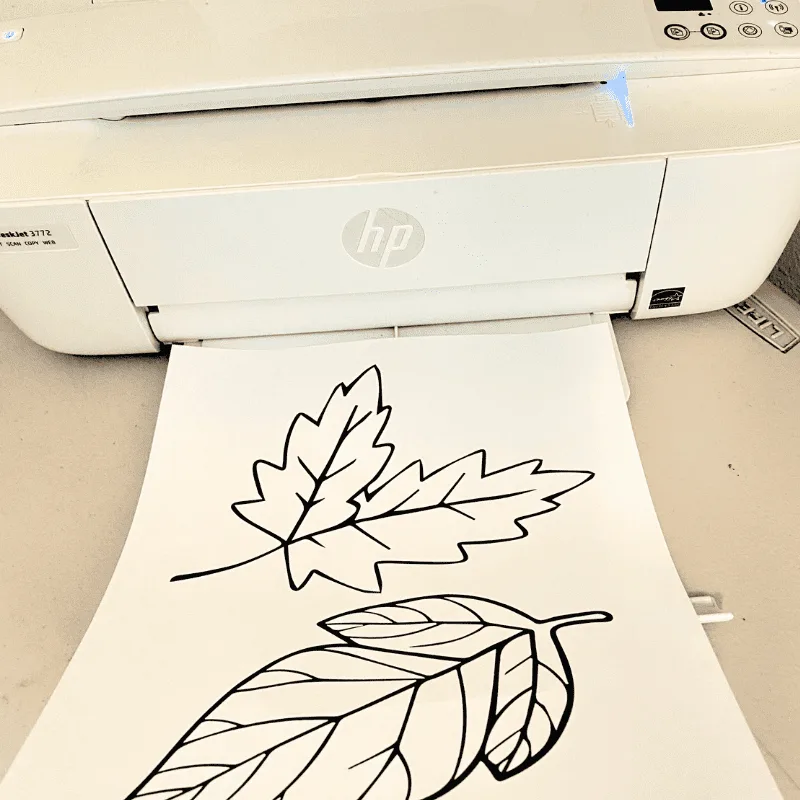 Once you have finished printing your coloring sheet(s), give the ink a few minutes to fully dry and set while it's still on the printer. This precautionary measure will prevent any ink smudging on your coloring page, which can be especially important if you plan to gift your artwork to a special someone.
Once you have finished printing your coloring sheet(s), give the ink a few minutes to fully dry and set while it's still on the printer. This precautionary measure will prevent any ink smudging on your coloring page, which can be especially important if you plan to gift your artwork to a special someone. -
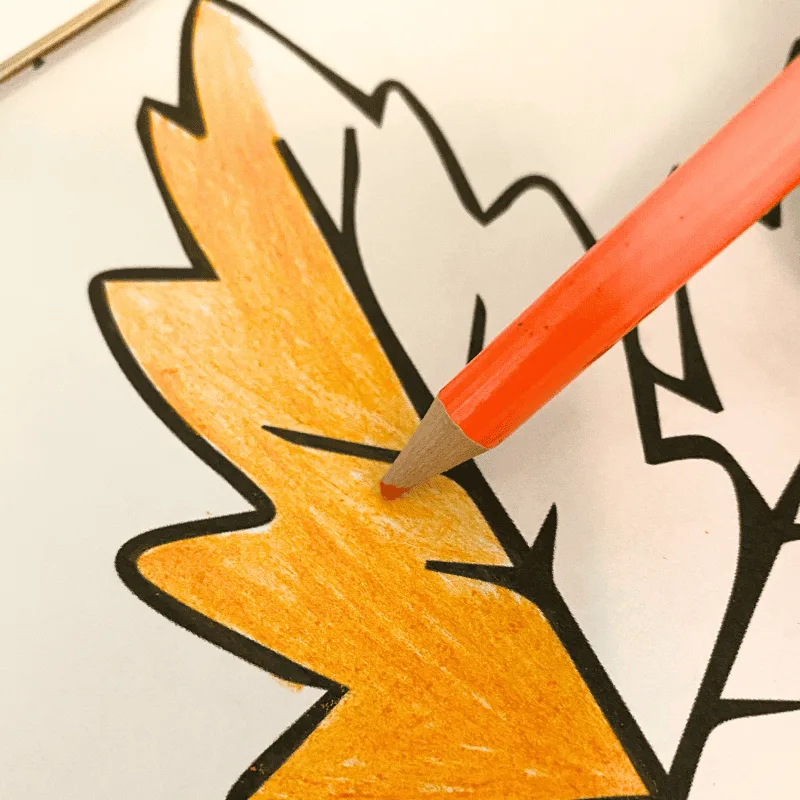 Prior to embarking on your coloring journey, ensure your hands are thoroughly washed and completely dry. Next, make sure to locate a clean, flat surface to lay your paper on, and then unleash your creativity as you infuse the prints with your unique colors and vision. As you finish coloring, relish the newfound sense of achievement, recognizing that these delightful creations have the potential to bring joy to you and others for years to come.
Prior to embarking on your coloring journey, ensure your hands are thoroughly washed and completely dry. Next, make sure to locate a clean, flat surface to lay your paper on, and then unleash your creativity as you infuse the prints with your unique colors and vision. As you finish coloring, relish the newfound sense of achievement, recognizing that these delightful creations have the potential to bring joy to you and others for years to come.
Notes
Ideas on what to do with these leaf pictures:
You could buy some simple frames, have the images printed onto a quality card stock at a local printing company, color them as well as you can, and they could be added to your homes decor.
You could print out the images and bind them, pair them with some nice colored pencils or an art set, which could be a distinctive gift concept for any occasion, especially for those who have a passion for coloring. It's a thoughtful way to brighten someone's day, or simply to bring joy whenever the need arises.
They can also double as a source of inspiration or as templates for crafting intricate fine-line tattoos.
These free leaf coloring pictures can also be used as embroidery patterns by simply using transfer sheets.
Naturally, you also have the choice to just plain print them out and enjoy endless hours of fun by coloring them repeatedly.
*The instructions, primarily designed for iPhone users with HP printers to achieve the highest print quality, can also be similarly applied to a wide range of other devices.
** Whenever possible, it's advised to utilize the "fit to page" feature before printing to ensure the the entire image makes it onto your printed coloring page.
*** This website uses an image optimization technique for the provided sample illustrations. While this optimization enhances page loading speed, there is a slight compromise in terms of image quality. For optimal results, we recommend downloading and directly using the included PDF file. The sample image serves as a general visual preview since navigating through an entire PDF may present challenges on certain devices, potentially limiting the ability to view the complete image in a single screenshot.
Recommended Products
As an Amazon Associate and member of other affiliate programs, I earn from qualifying purchases.
-
 Looney Zoo Temporary Tattoo Markers for Skin, 10 Body Markers + 20 Large Tattoo Stencils for Kids and Adults, Dual-End Tattoo Pens Make Bold and Fine Lines with Cosmetic-Grade Temporary Tattoo Ink
Looney Zoo Temporary Tattoo Markers for Skin, 10 Body Markers + 20 Large Tattoo Stencils for Kids and Adults, Dual-End Tattoo Pens Make Bold and Fine Lines with Cosmetic-Grade Temporary Tattoo Ink -
 Printworks Vanishing Embroidery Transfers, for White/Light-Colored Fabrics, 12 Sheets, Inkjet, 8.5 x 11 (00524)
Printworks Vanishing Embroidery Transfers, for White/Light-Colored Fabrics, 12 Sheets, Inkjet, 8.5 x 11 (00524) -
 eletecpro 12x16 Picture Frames Set of 5, Display 8x10 or 8.5x11 Photo Frame with Mat or 12x16 without Mat, Wall Gallery Poster Frames, Photo Frames Collage for Wall Display
eletecpro 12x16 Picture Frames Set of 5, Display 8x10 or 8.5x11 Photo Frame with Mat or 12x16 without Mat, Wall Gallery Poster Frames, Photo Frames Collage for Wall Display -
 U.S. Art Supply 163-Piece Mega Deluxe Art Painting, Drawing Set in Wood Box, Desk Easel - Artist Painting Pad, 2 Sketch Pads, 24 Watercolor Paint Colors, 24 Oil Pastels, 24 Colored Pencils, 60 Crayons
U.S. Art Supply 163-Piece Mega Deluxe Art Painting, Drawing Set in Wood Box, Desk Easel - Artist Painting Pad, 2 Sketch Pads, 24 Watercolor Paint Colors, 24 Oil Pastels, 24 Colored Pencils, 60 Crayons -
 Sacnahe Tattoo Transfer Stencil Machine Copier Printer Thermal Tattoo Kit Copier Printer With 20pcs Free Tattoo Stencil Transfer Paper Black (2023 Update Version)
Sacnahe Tattoo Transfer Stencil Machine Copier Printer Thermal Tattoo Kit Copier Printer With 20pcs Free Tattoo Stencil Transfer Paper Black (2023 Update Version) -
 PRINA Art Supplies 120-Color Colored Pencils Set for Adults Coloring Books with Sketchbook, Professional Vibrant Artists Pencil for Drawing Sketching Blending Shading, Quality Soft Core Oil Based
PRINA Art Supplies 120-Color Colored Pencils Set for Adults Coloring Books with Sketchbook, Professional Vibrant Artists Pencil for Drawing Sketching Blending Shading, Quality Soft Core Oil Based
Coloring tips
Coloring a picture of a leaf or foliage can be a relaxing and enjoyable activity.
Here are some of my tips and tricks to make your leaf-themed coloring pages look vibrant and realistic:
- Study Real Leaves: Look at real leaves or reference images to understand their colors, textures, and patterns. Observing nature is the best way to get inspiration and accuracy.
- Layering Colors: Begin by applying a base color that matches the leaf’s general hue. Then, layer different shades of the same color to create depth and dimension.
- Use Colored Pencils: Colored pencils are excellent for detailed work and blending. Experiment with different pressure levels to achieve various shades and textures.
- Blending Techniques: Explore blending techniques such as burnishing (applying heavy pressure), layering, and using blending pencils or blending stumps to smooth transitions between colors.
- Highlight and Shadow: Add highlights with a lighter color or white to create a glossy or reflective look. Shadows can be achieved with darker shades or by layering colors in areas where light doesn’t reach as much.
- Texture and Veins: Pay attention to the leaf’s texture and vein patterns. Use fine lines or dots to replicate these details accurately.
- Watercolor or Markers: If you prefer a more fluid and expressive style, try watercolor pencils, markers, or even actual watercolors for a loose and painterly effect.
- Experiment with Backgrounds: Consider adding a complementary background to your leaf drawing. This can enhance the overall composition and make the leaves pop.
- Color Harmony: Think about the color harmony of your artwork. Use a color wheel to select complementary or analogous colors for a visually appealing result.
- Practice Patience: Take your time and enjoy the process. Coloring leaves can be intricate, so patience is key to achieving a satisfying result.
- Protect Your Work: Once you’ve finished coloring, consider using a fixative spray to set the colors and prevent smudging.
- Blend Real and Imaginary: Don’t be afraid to add your creative touch. While realism is great, adding some imaginative elements or using unconventional colors can make your artwork unique and captivating.
- Draw Inspiration from Seasons: If you’re coloring leaves for a specific season, pay attention to the colors associated with that time of year. For example, vibrant greens for spring and rich reds and oranges for autumn.
- Experiment and Learn: Coloring is a skill that improves with practice. Experiment with different techniques, tools, and styles to find what works best for you.
- Stay Relaxed: Coloring is meant to be a relaxing and enjoyable activity, so don’t stress too much about perfection. Embrace imperfections and have fun with your creative process.
Remember that there are no strict rules in art, and your interpretation of leaves and foliage can be as unique as you are.
Whether you aim for realism or prefer a more abstract approach, the most important thing is to enjoy the creative journey.
Options For Printing:
Letter L is for leaf writing practice worksheets
*Please note that the coloring sheets in my letter practice collection are tailor-made for classroom usage.
Unlike other printables on this page, they do not require written permission for public use.
However, if anyone inquires about their source, please share the link to this post. Thanks, I really appreciate it!
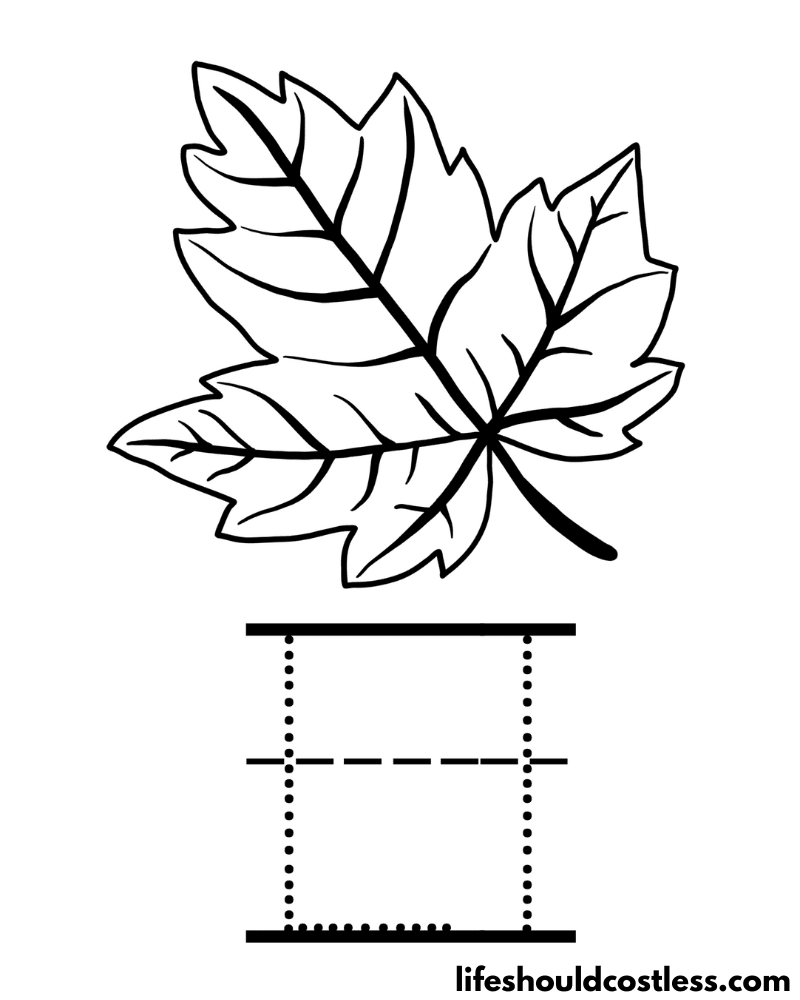
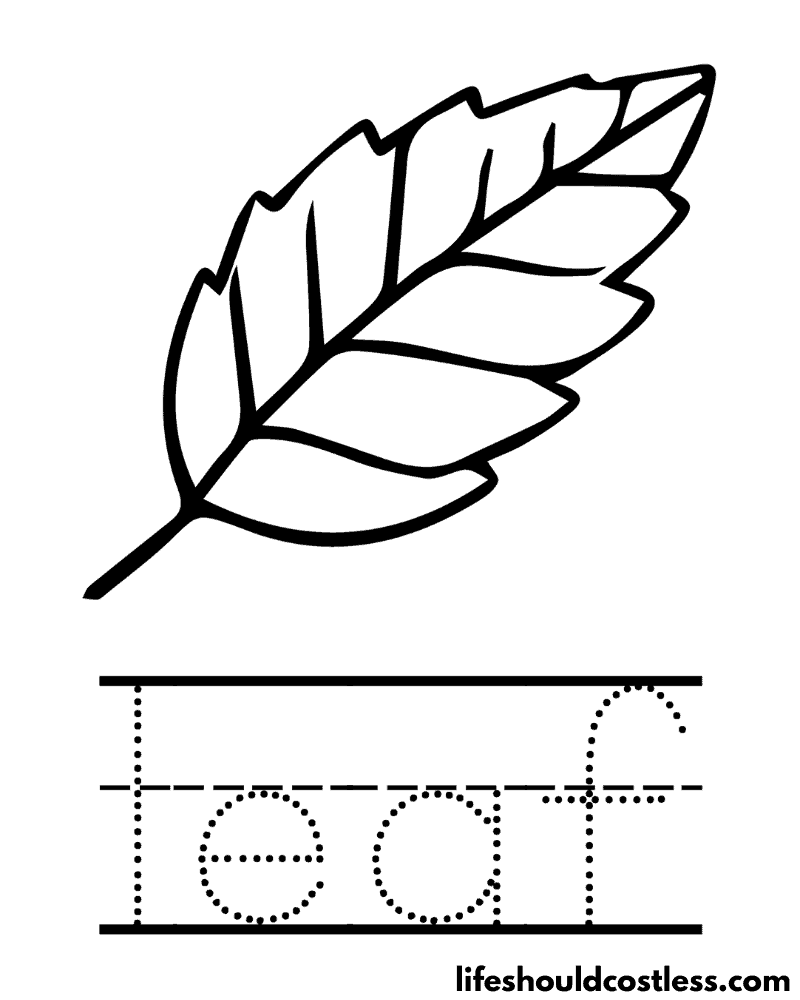
Various Other Leaf Designs:
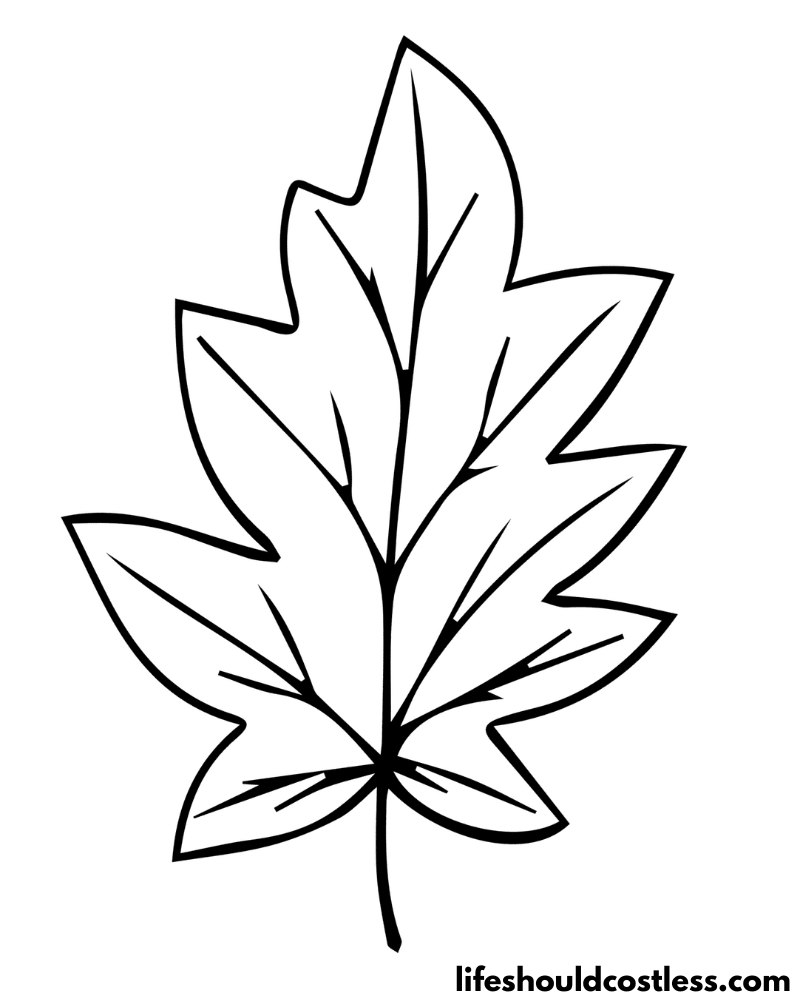
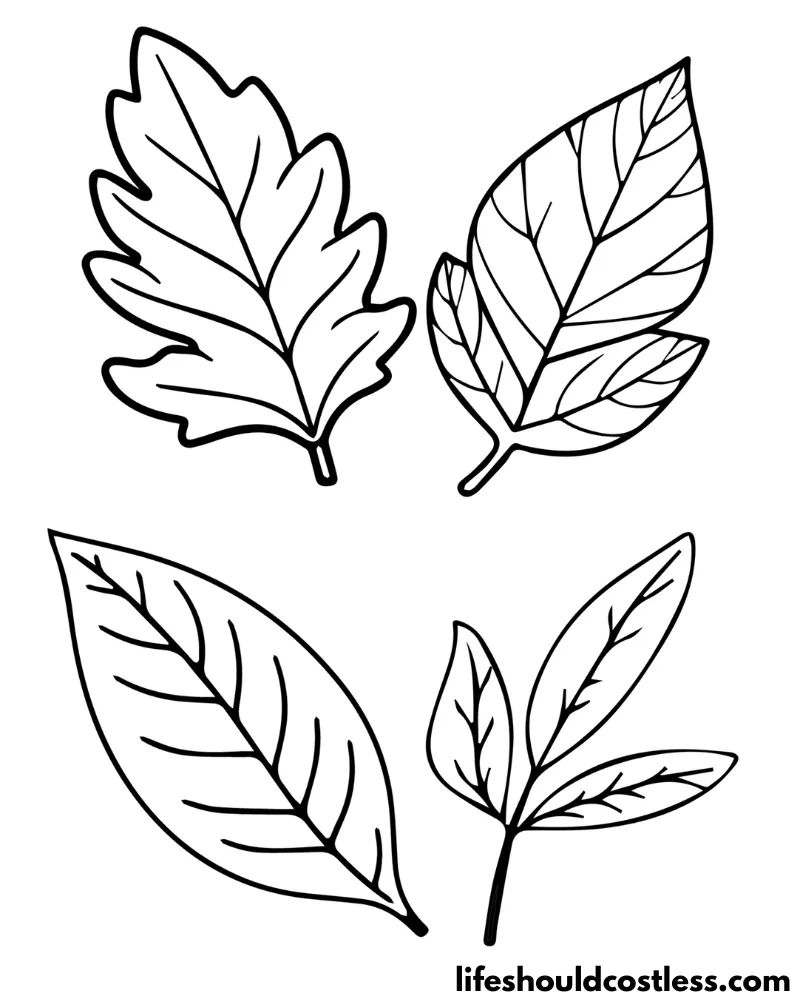
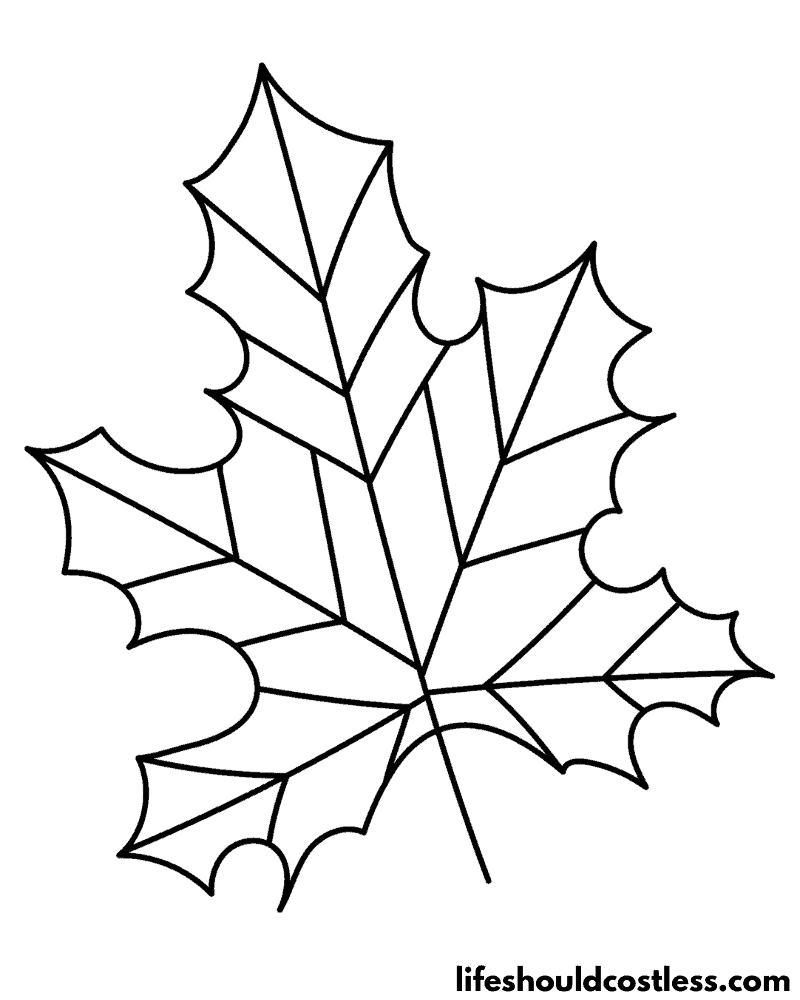
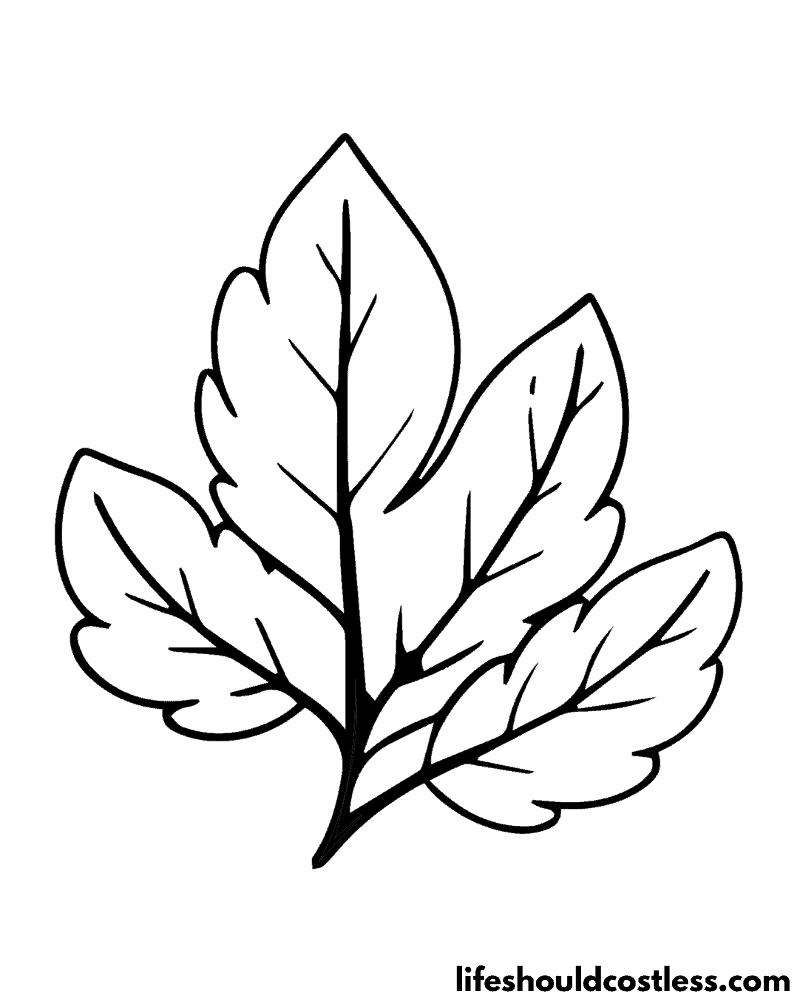
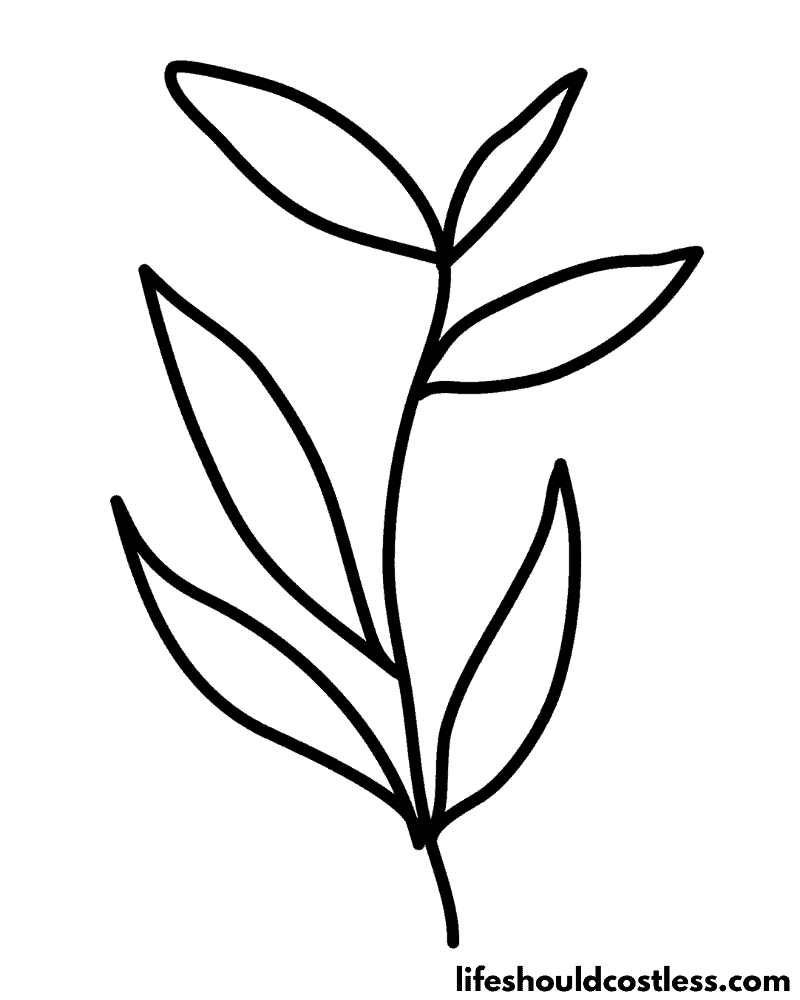
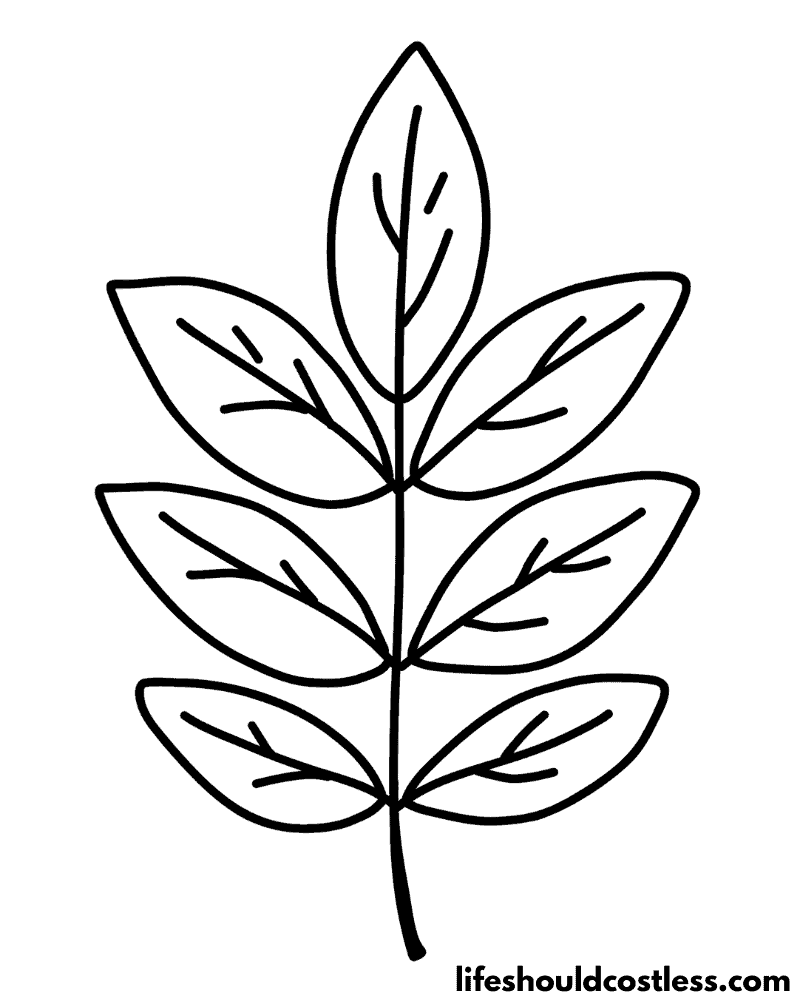

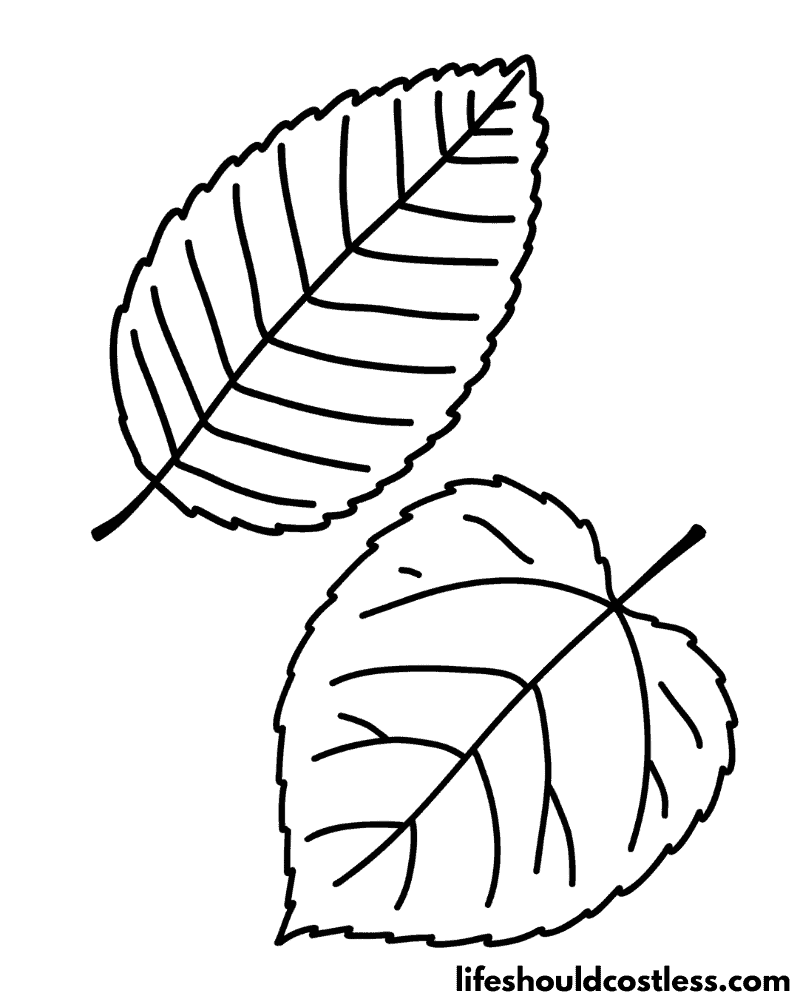
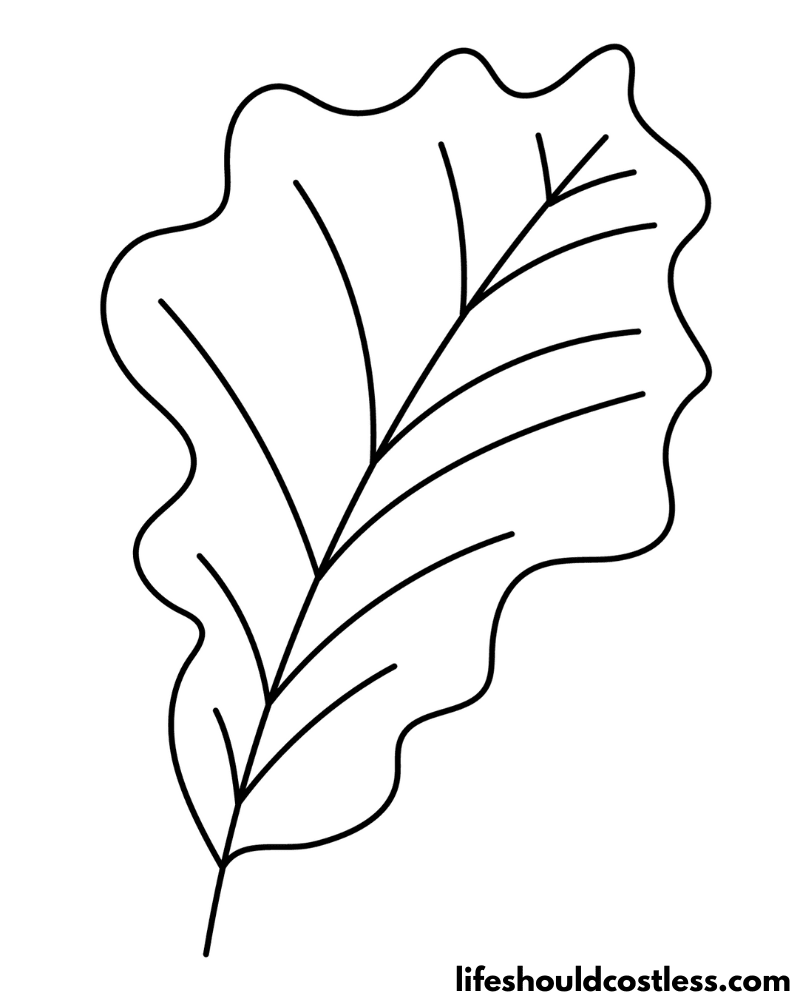

FAQ’s
Leaves come in various colors depending on the type of plant, the season, and their health. The most common leaf colors are:
Green: The predominant color of healthy leaves is green, thanks to the presence of chlorophyll, the pigment responsible for photosynthesis. Different shades of green can vary from light to dark.
Red: Some leaves, particularly during the autumn season, turn shades of red. This color change is due to the presence of anthocyanin pigments.
Orange: Like red, orange leaves in the fall are the result of anthocyanin pigments mixing with carotenoids.
Yellow: Yellow leaves are often associated with autumn foliage as carotenoid pigments become more visible when chlorophyll breaks down.
Brown: As leaves age and lose their chlorophyll, they can turn brown. This is especially true for deciduous trees as they prepare to shed their leaves in the fall.
Purple: Some plants have naturally purple or purplish-red leaves, even during the growing season. This color is often attributed to anthocyanin pigments.
Variegated: Certain plants have leaves with a combination of colors, such as green and white or green and yellow, resulting in a variegated appearance.
Silver/Gray: Some plants have silver or gray leaves, which can be adaptations to reduce water loss or protect against intense sunlight.
Blue: Blue leaves are rare in nature but can be found in certain succulent plants, like some varieties of agave.
White: Some plants, like certain varieties of hostas, have leaves with white variegation or entirely white leaves.
It’s important to note that leaf colors can vary widely between different plant species and even within the same species due to genetic, environmental, and seasonal factors.
The changing colors of leaves in the fall are particularly iconic and celebrated in regions with distinct seasons.
*I will add more leaf colour / color questions and answers as the questions get sent to me.
Conclusion
In this article on leaf coloring pages, we’ve embarked on a journey that celebrates the natural world, artistic expression, and the joy of learning.
As we conclude our exploration, it’s evident that these fun designs of leaves extend far beyond mere coloring; they encapsulate a profound connection between art and nature.
Throughout this page, we’ve uncovered numerous fascinating facts about leaves, shedding light on the extraordinary variety and complexity within the plant kingdom.
From the remarkable process of photosynthesis, which sustains life on our planet, to the astonishing array of leaf shapes, sizes, and colors, we’ve come to understand the leaves as not only essential components of the natural world but also as artistic marvels in their own right.
The act of coloring itself becomes a therapeutic and mindful endeavor, allowing us to immerse ourselves in the calming strokes of colored pencils or markers.
It’s a practice that transcends age and skill level, fostering relaxation, mindfulness, and creative expression.
Whether you’re a young child discovering the wonders of the world around you or an adult seeking a respite from the demands of daily life, coloring leaf images offers an opportunity to reconnect with the beauty of the outdoors.
It provides a unique educational experience, blending art and science seamlessly.
It also encourages us to pay attention to details, explore various color palettes, and develop our understanding of the intricate features that make leaves so distinct.
This union of art and science can be a powerful tool for educators, parents, and learners of all ages, fostering a deeper appreciation for the natural world.
Happy coloring!
Thanks so much for stopping by my blog and supporting my endeavors to make people’s lives a little easier/better/more affordable.
If you liked this post, or found it helpful in any way, please make sure to share it with your family, friends, and co-workers via social media.
Or you could even send them the direct link via email. Whichever way you choose to spread the love, I super appreciate it! ~Sarah
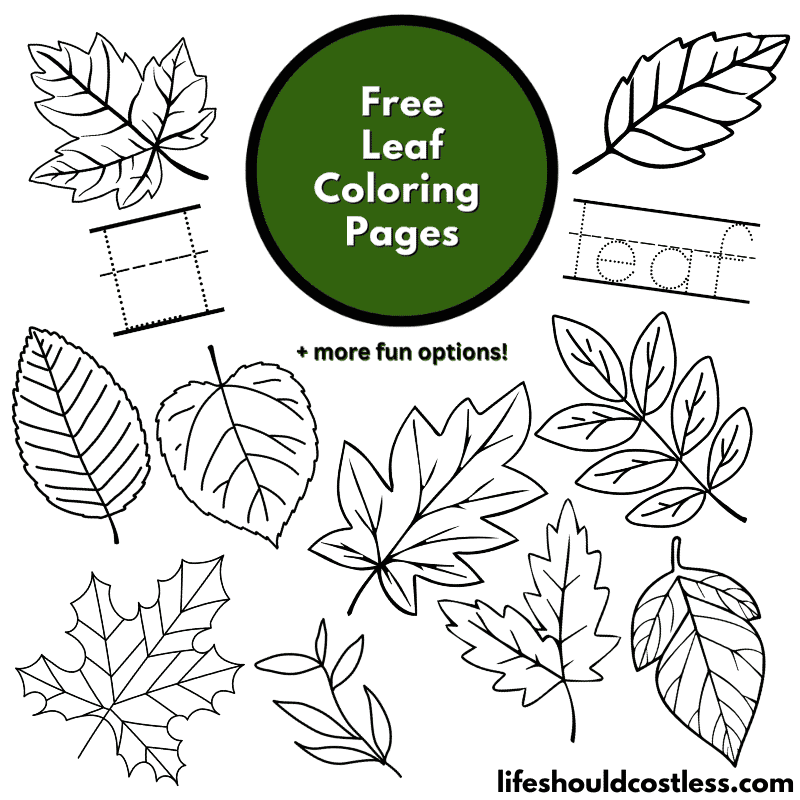
How to follow & support this site
- If you would like to subscribe to my email list, go here.
- Make sure to follow along via social media, by going here.
- If you would like to learn how to really show your support to this site (at no cost to you), go here.
- If you would like to make a direct donation to the site, go here.
Check out my other free printables
- To see all of my free printables, go here.
- To see an alphabetized index of my coloring pages, go here.
- To see all of my botanicals coloring pages, go here.
- To see all of my floral coloring pages, go here.
- To see all of my holiday/seasonal coloring pages, go here.
- To see all of my fall/autumn coloring pages, go here.
Otherwise, here are direct links to several of my other related posts that you’re also going to love:
Botanicals / Floral & Misc
Botanicals / Fruits
Fall Coloring Pages
Halloween
Thanksgiving
Winter Coloring Pages
Christmas
New Years
St. Patrick’s Day
Valentine’s Day
Spring coloring pages
Easter
Summer coloring pages
Other good resources for a printable leaf:
- https://www.itsybitsyfun.com/leaf-coloring-pages.html
- https://www.firstpalette.com/printable/leaf.html
- https://timvandevall.com/templates/leaf-templates/
*This post was originally shared to this blog on 05/04/2023, & has since been updated to improve user experience, add video instruction, as well as to make it as shareable as possible across the social medias.
**Please note that I do try my hardest to provide factual, but easy to understand, information about each topic. If you notice a discrepancy in my coloring pages, facts, or see something that you deem “misinformation/incorrect” please make sure to notify me about it. I would prefer that you send me an email with a link to a more reputable resource on that subject, so that I can correct it as soon as possible. Thanks so much for helping this site become the best that it can be!
***Resources from djinkers were used in the production of this article.
